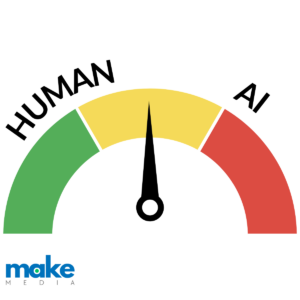AI detector test results: just how accurate are AI detectors? I ran 5 tests on a range of content types and AI models.
This is an increasingly important question as AI detectors become more prevalent. In March 2024, Google used its own detection tools as part of its “scaled content abuse” algorithm update designed to penalize content that was 100% written by AI.
Fast forward to mid-2025 and there’s a dramatic uptick in people searching for “undetectable AI’ as a way to cheat the system (see our analysis: Authentic Content vs. Undetectable AI).
Here’s the good, the bad, and the ugly about the detection algorithms, including some surprising results that will give you pause about false positives.
Table of Contents
AI Detectors: False Positives or Accurate?
To see how accurate the publicly available detectors are, I tested AI- and human-written content with AI detector, zerogpt.
AI Detector Test 1: Human Written Speech

First up was the graduation speech I gave at my alma mater, the University of Maryland Commencement, back in 2011, which I spent over 3 weeks writing and editing.
It’s 100% written by me and titled How to Win the Lottery (enjoy reading if the topic interests you).
The AI detector said 12% was written by AI.
That’s clearly a false positive. There were no generative AI tools back in 2011. The parts of the speech that registered as false positives seemed to be related to how I phrased certain sentences.

On a positive note, the speech when reviewed in its full context was under the threshold to be marked as AI generated. More on this in Test 5.
Yet this is still a bit of a red flag because it could influence writers to change their style to avoid being labeled “generated by AI” for their original work.
It is especially troubling for schools who rely on AI detectors to monitor students’ work. It could lead to false accusations of submitting work that is not their own, even when it is.
AI Detector Test 2: LinkedIn Posts
Next up were some of my LinkedIn posts, which I personally write without any AI help. I post marketing and leadership ideas on LinkedIn daily.
Most posts got a 0% AI score. Some were in the teens.
But one scored 37% AI, yet it was 100% my writing. Another false positive.

This is also concerning, though not as much as Test 1. LinkedIn has an AI content problem that’s rampant. Many posts and comments are clearly AI generated. You can figure that out simply by reading them if you’re familiar with common ChatGPT phrases and patterns of writing.
AI Detector Test 3: Expert Article
Curious, I tested an article that one of my writers drafted for a project. He’s an excellent writer and has done many assignments for me. I know he wrote the piece I because it flowed very closely with an interview I did with the client. Again, 100% human written but the AI detector flagged parts of it.

It scored 19% AI.
This is very similar to Test 1, where the detector got a partial false positive for content I personally wrote without AI.
I wanted to check this against industry reports from reputable organizations to see how well they fared. Here’s a look at a popular one, Goldman Sachs Creator Economy Report which is frequently cited for its prediction that the creator economy will be $500 billion by 2027.
This well-written report that includes data clocked in with an AI detector score of 27% AI-written. Big time false positive.

This is worth noting. Even the top organizations in the word have human-written content partially detected as AI generated. I tested a few other long articles as well and got similar false positives, which leads me to something I consider to be an important finding:
- Long-form human-written content consistently has portions flagged as AI
It seems that the detection algorithms almost always score long-form content as having some degree of AI-generated text, even when they are 100% written by humans. I presume this is because if it finds a match with a typical GPT phrase, it thinks AI wrote it.
So, fellow humans, this adds to the argument that we need to watch how we write to ensure we don’t sound like AI.
Go figure.
AI Detector Test 4: AI Generated Content

A full test wouldn’t be complete without testing content that was generated completely by AI. I used a basic prompt to have AI write content with only a few small updates to the default settings. I did this with a number of prompts to see what kind of scores I would get.
It scored 65-93% AI consistently.
This is more in line with what I expected. Even when reading it myself, I found the flow and overall tone to reflect the generic output of AI. I tested GPT-4o and Llama 3-7B, and Claude 3 Sonnet. The latter two had higher AI scores.
AI Detector Test 5: Convert a Transcript (Most Interesting)
There’s a big difference between getting AI to write everything for you entirely and simply converting your thoughts into prose.
For this test, which validates why MakeMEDIA’s content is far better than generic out-of-the-box AI content, I converted a transcript of me talking about a topic I’m very familiar with. This is the process we use at MakeMEDIA: start with an outline, talk about the topic, then convert the transcript into an article. It’s the way journalists and writers often produce high quality content that contains unique thoughts and stories.
More so, it is the AI SEO Best Practice process we’ve refined after numerous tests with SEO clients who were able to secure top rankings.
In the prompts I tested, I used extremely specific details. The initial prompt was over 3 pages long. I generated 10 variations with and without specific lines of instruction.
It scored between 15-62% AI.

In each variation, it retained the overall material I covered in my recording. But there were specific prompt triggers that flipped the score from mostly human to mostly AI. MakeMEDIA tests these variations to deliver the best output for your content.
The long-form article in this test is ranked #1 on Google for a moderately competitive search term. It beat out pages from IBM and a government website, which is very difficult to do. This article debuted on page 2 of Google’s search results and within two months got onto page 1, then made its way to the top slot after four months.
→ This is big.
It implies that when you use AI to convert very rich transcripts (albeit with very specific prompts that are over 3 pages long themselves), you increase your human readability score and your chances of ranking well on Google.
More so, when you read such articles, they truly read like they are human written – because they start with human thoughts not repurposed AI training data.
Important to note: this article included SEO best practices, such as embedded videos of the interview that was transcribed, keywords in heading and body text, and images. These additional items are important in helping content rise to the top slots in search results.
I tested another transcript that was shorter. It still scored quite well, but had indications of slightly higher AI phrasing. The implication here is that longer transcripts provide an extra opportunity for AI to feel closer to human-written content than shorter ones.

Mind you, some of my 100% human-written LinkedIn posts scored 37% AI and my long-form 100% human-written content hovers around 20% as an AI score. So getting 15% for converting a transcript is quite good. Compare that to the AI-only content in Test 4 which generated content that was so obviously AI-generated upon reading it and confirmed by its high AI detection scores.
The more stories and examples in the transcript, the lower the AI detector score, meaning it feels more human. When you read the content created using this process, you can tell the difference.
What These AI Detection Test Results Mean
While there are some AI phrases that are easily detectable by us mortals, AI detectors get a lot wrong. But they do get a lot right.

From my tests, I would look at an AI detector score as somewhat binary even though there are gray areas like Test 5 (converting transcripts into articles).
- Scores below 50%: human written
- Scores above 50%: AI written
If you want to view the AI detection results as more granular indications, you could break it down into a low, middle, and high range like this:
- Scores below 30%: human written
- Scores between 31-69%: hard to tell
- Scores above 70%: AI written
SEO, AI Detectors, and Google
You might be thinking, “what does this mean for my SEO on Google?”
Relevant content that speaks to your audience and is backed up by your experience and expertise makes a huge impact on your rankings. Using MakeMEDIA, you can generate content ideas that will resonate with your audience and get a detailed outlined that is designed to capture your stories and experience.
Nobody, and especially not AI bots, can replicate your stories.
And that makes your content much more rankable.
Creating High Quality Content Fast
There is an important SEO concept called content clustering. Publishing one article won’t get you ranked. The more helpful content you publish, the more Google sees you as an authority.
Your content clusters will give rise to your rankings.

At MakeMEDIA, we strive to get the AI detection score below 30%, which is well within the range of human-written content. When you read it, you can feel the human elements because the content is rooted in a human conversation. We’re simply taking your thoughts and creating an article from them, just as a marketer or writer would do.
Remember though, it’s still AI writing the article, not a human. You might want to add your own editorial touches before you publish, which take just a few minutes.
MakeMEDIA will automatically embed certain on-page SEO elements, like keywords in your body text, internal links, and heading breakdowns.
But there are a few things you’ll want to add to get it to the SEO finish line:
- Embed images that contain IMG ALT tags of keywords.
- Add links to other articles on your site as well as articles on other sites.
- If your content is an educational piece, link to an author page to reinforce your expertise.
- Update relevant older articles with links to your new ones.
- Mention your new content on social media.
The key to getting ranked is to use the content MakeMEDIA helps you create and add the final touches to boost your SEO signals.

